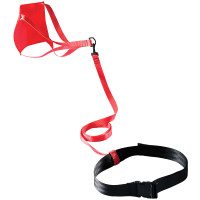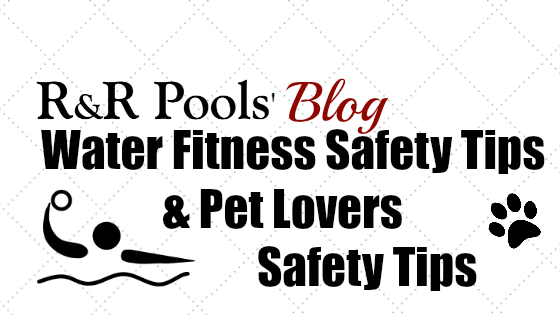Safety Month at R&R Pools continues with some safety tips for the water aerobics lovers and the pet lovers!
Water Fitness:
Water fitness is both healthy and effective. It increases stamina, agility, and strength while assisting in weight loss. Physical exercise in a swimming pool also helps safeguard bones and joints from the grueling effects of high-impact exercise. Nevertheless, swimmers should take safety measures to decrease the chance of injury or drowning. If you work out in the water, we recommend that you follow these safety procedures while exercising:
- Always check with your doctor prior to starting any exercise program, including water fitness activities. A pre-existing condition could pose a safety problem if it’s intensified by your water workout.
- Familiarise yourself with your swimming pool. If you’re working out in a public pool, acquaint yourself with fluctuations in depth and safety features before starting your workout. Even if you work out in your own pool, review these items; the shallow end will seem a lot further away when you’re tired from a workout.
- Work out with a companion or at a pool with an on-duty lifeguard whenever possible. When you’re recovering from an injury you should work out with an instructor or physical therapist or stay in the shallow end of the pool.
- Match your water workout to your swimming ability. There are plenty of water exercises you can do in the
 shallow end of the pool if you aren’t a strong swimmer. There are also many devices you can use, such as a swim parachute, that aide in your work out.
shallow end of the pool if you aren’t a strong swimmer. There are also many devices you can use, such as a swim parachute, that aide in your work out. - Start slowly and don’t misjudge your abilities. It’s better to advance slowly and stay safe than to take risks in the pool and have an accident.
- If you are too cold or too hot, feel dizzy or nauseated, or suffer even a minor injury, get out of the pool immediately.
- Be sure to spread water workouts throughout the week instead of attempting to complete your entire workout program i
 n a day or two. Exercising for too long or too aggressively will escalate the chance of injury. Injuries will increase your risk of drowning.
n a day or two. Exercising for too long or too aggressively will escalate the chance of injury. Injuries will increase your risk of drowning. - Drink water before and after your workout to avoid dehydration. If the swimming pool you exercise in is outdoors, avoid exercising during the warmest parts of the day throughout the summer months.
- Prior to exercising the any fitness gear, such as trainers, parachutes, barbells, bikes and treadmills, you should always read and follow all safety measures in the owner’s manual.
- Use a pool noodle or water exercise buoyancy belt to provide flotation when you walk or jog in the deep end of the pool.
- Keep a cellphone in a waterproof cover poolside every time you work out in the water.
- Make sure the pool you work out in is well kept at all times.
Pet Lovers:
If your treasured fur baby loves fun in the sun and cooling off in the pool, keep these safety tips in mind to help keep them safe. The following pet water safety tips can be applied to swimming pools, hot tubs, boating, and beaches:
- When the pool is not in use, cover it with a pool safety cover. Safety covers can be walked on and will prevent your pets from falling (or jumping) in and becoming trapped in the pool or tangled in a winter cover.
- Pets can tire easy and they have poor depth perception in the water. Be aware if they appear to be too tired to swim. Always be nearby to assist them when they want to exit the water as they may not be able to locate the pool steps or ladder. Never leave your fur baby unattended in the water.
- Pet’s body temperatures differ than ours, so be aware of the hazards of hypothermia. Some signs of hypothermia are shivering, dilated pupils, reduced heart and respiratory rate, blue or pale gums. If you think your pet may have hypothermia, wrap them in a blanket with warm water bottles, and take them to your veterinarian as soon as possible.
- Pool alarms can be attached to your pet’s collar and alert you if they come in contact with water. These pool alarms will also work for boating, ponds and lakes.
- If your pet is going to be out in the sun, and possibly in the water, you should rub them down with a sunscreen. Similar to our skin being sunburned, your pets can be as well. Water can cause the fur to become flush with their skin exposing it to the sun.
- Have your pet wear a dog life jacket while around the water. Dog life vests will keep your pet
 buoyant and be an extra sense of safety. Dog life jackets are available for animals of all sizes.
buoyant and be an extra sense of safety. Dog life jackets are available for animals of all sizes. - You should NEVER permit your pet to be in the hot tub or spa. The high temperatures these are normally kept at are too hot for any animal and can cause them to overheat. Dogs and cats do not perspire like we do and their panting will not be sufficient enough to remove the extra heat from their bodies.
These are just a few pet safety tips to have in mind. Our pets are family and keeping them safe is just as important. Playing in the water with your pet can be fun and safe at the same time!

